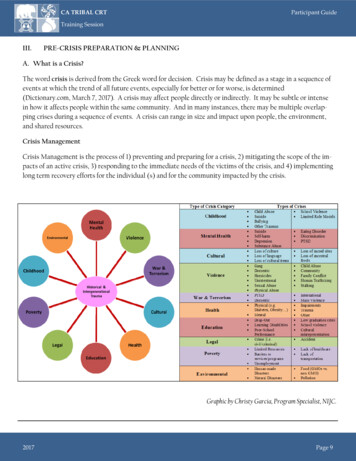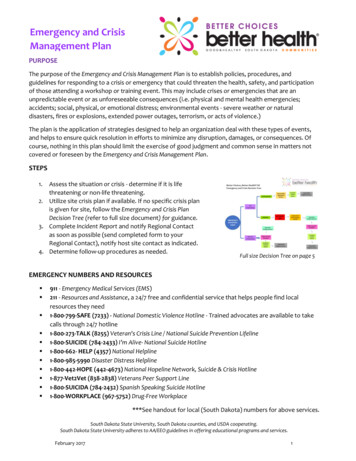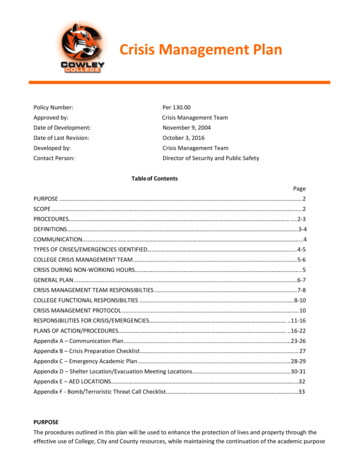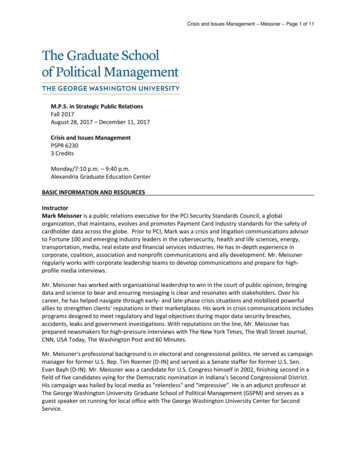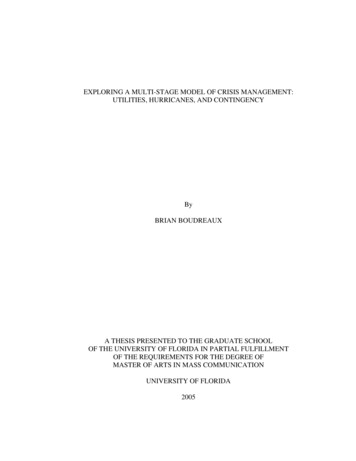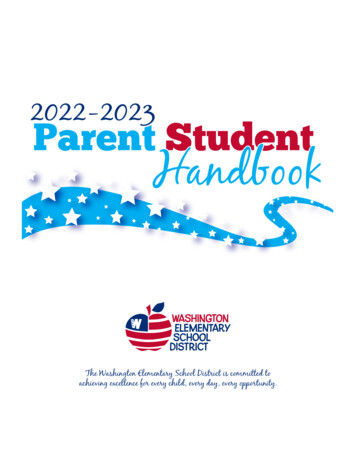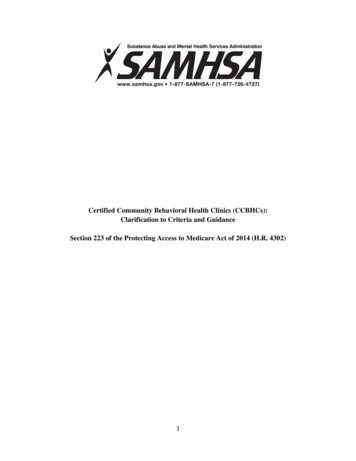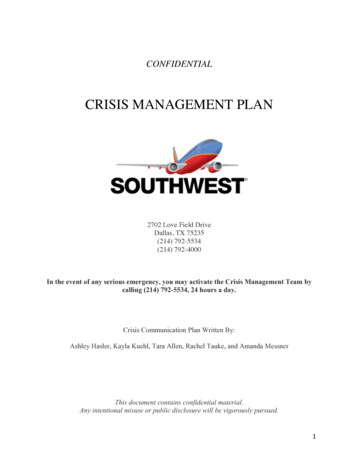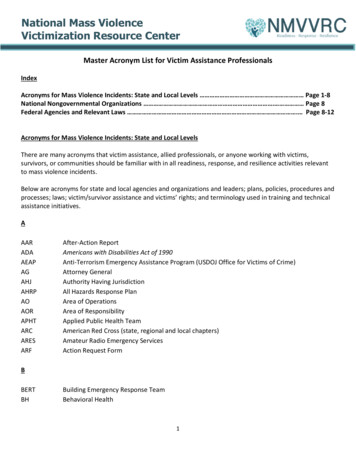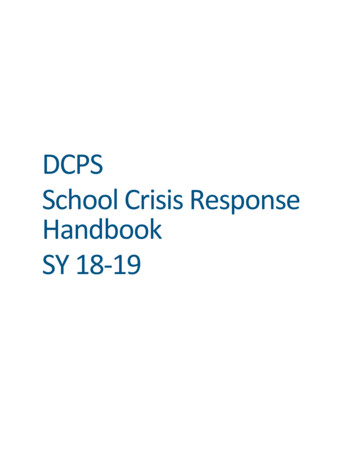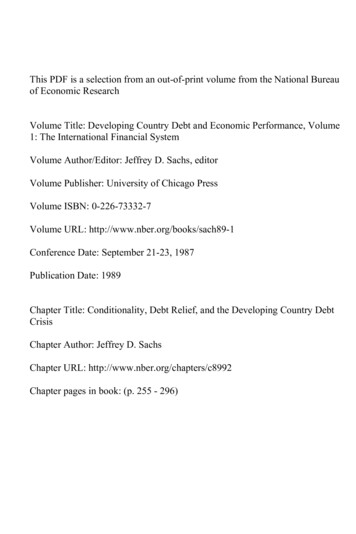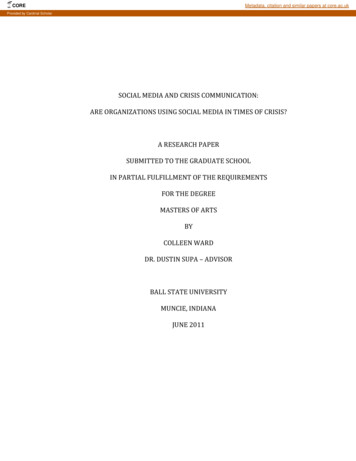
Transcription
Executive Masters in Crisis and Emergency ManagementUNLVECEM 713: EVOLUTION OF TERRORISM -- FALL 2016Course Content:This course focuses on the historical roots of terrorism and stresses the importance ofunderstanding the past to adequately prepare for the future. Through a historical perspective ofterrorism, this course provides the basis for and discusses the aspects that make contemporaryterrorism of today different from the traditional terrorism of the past. In addition, organizationalstructures and favored tactics of major terrorist organizations are discussed, the history of stateterrorism is explored, an emphasis on the rise and growth of religious terrorism is undertaken,the power of media coverage is addressed, and the impact of the Global War on Terrorism on thefuture of terrorism is debated.Course Learning Objectives: At the completion of the course the student will be able to: Define the major components of terrorism and list the reasons why we study it.Explain the problem of multiple terrorism definitions and the importance of having a unifiedterrorism definition.Describe examples of terrorism throughout the agesProduce an example of terrorism in contemporary society and the world.Compare and contrast historical terrorism with modern terrorism.Compare the differences between domestic and international terrorism.Compare the differences between secular and religious terrorismIdentify examples of state terrorism throughout historyList the characteristics of terrorist organizations.Describe how modern terrorism is tailored to the media.Discuss why terrorism will continue into the future and predict future terrorism trends.List the major issues of cyber terrorism.Course Learning Outcomes: At the completion of the course the student will be able to: Understand the evolution of terrorism and the underlying social, political and economiccauses of terrorism. Comprehend the human side of emergencies by analyzing psychological, economic andsociological impacts associated with different disasters and how they differ based on gender,functional need, age, religion, educational level, a socio-economic status that affect thepublic reaction and response to different terrorist disaster events.
Books: Terrorism in the Twenty-First Century by Cindy C. Combs. Seventh Edition. LongmanPublishers. 2013. A World Ignited: How Apostles of Ethnic, Religious, and Racial Hatred Torch theGlobe by Marin & Susan J. Tolchin. Rowman & Littlefield. 2006. Counter Terrorism Issues: Case Studies in the Courtroom by James OttavioCastagnera. CRC Press. 2013Objectives Measurement:All assignments are to be submitted through Blackboard Leaning. E-mail with attachments bythe due date. You may submit the assignments earlier if you desire, but no papers will beaccepted after the due date expires. All assignments must be completed (regardless ofpoints) to receive a grade for the course. For your regular assignments, grades will be basedon the following factors: Grammar, Spelling, Length & meeting all requirements for theassignment.Grading Scale Total Points: 300 points:440-489:A391-439:B342-390:C341 and below Not PassingReading and Writing Assignments:* 9 weekly or bi-weekly reading and written assignments worth 20points each.* 3-part research paper worth 40 points for each part. A separate titlepage is required for each part of the research paper. Minimum 4 fullpages.For this research paper, the student will address the following questions:Part 1: Does the psychological, motivational and personality make-up oftraditional terrorists throughout history are different from those ofmodern-day terrorists? Explain your position with various researchsources as explained in the syllabus. You must use independent research
sources. Please utilize historical examples. In other words, I would likeyou to go back in time and look at terrorist organizations like the Zealots forexample in ancient times and other classical terrorist movements of the 17th,18th and early and middle 19th centuries and compare the similarities anddifferences with that we see in our modern terrorists of today.Part 2 "The more things change - the more things remain the same".Discuss this concept through a historical evaluation of state terrorism.Please utilize historical examples from Ancient times, Middle Ages, 17th19th Centuries if possible and certainly Modern 20th Century and today.Part 3: Professor Samuel P. Huntington has contended that "thefundamental source of conflict in this new world will not be primarilyideological or primarily economic. The great divisions among humankindand the dominating source of conflict will be cultural.The conflictbetween civilizations will be the latest phase of the evolution of conflict inthe modern world," rather than the ideological tensions that were the sourceof the Cold War. Show through a historical analysis of terrorism that youagree or disagree with the thesis of Professor Huntington.Stylistic factors to remember in writing this research paper:1) Each part must be a minimum of 4 full typed, double-spaced pages with1-inch margins & 12 pt fonts.2) Notes--endnotes will be acceptable as footnotes, although other stylessuch as APA and MLA are acceptable as well. A separate title page for eachof the 3-parts is needed.3) Be sure to include page numbers and/or web pages that you use for yoursources.4) All quotes, statistics, and paraphrased material must have citations. Aminimum of 4 separate citations are to be shown in the body of the paperand directly shown in the works cited page.5) Academic journal articles are a very good source of information, such asTerrorism and Political Violence and Studies in Conflict and Terrorism. Seealso the web links.6) ***None of your textbooks or encyclopedias (ie. Wikipedia should beutilized as a resource.7) A separate title page is required for each part of the research paper.
Guideline for your 5 Discussion Posts.1. Your answer should be a minimum of three (3) paragraphs (minimum 350words in length).2. Choose at least two (2) posts to respond to incorporating the materials thatyou have learned from the class lectures, readings or your own research(minimum 100-150 words each). Be nice to each other.:)**How Does One Actually Discuss online:Please ask open-ended and thought-provoking questions in your posts andreplies. When you reply to your peers, reply with more that “I agree.” Make yourreplies substantive, and remember you can respectfully disagree as long as youprovide a rationale for your viewpoint. If you struggle with something meaningfulto say, or how to respond to a post, try these strong sentence starters: Sponge Bob’s comment made me think about. Although Professor Davis made a brilliant comment, I tend to disagree with hispoint about , I think to the contrary. I had not thought about Lebron James’ point that. I respectfully disagree with Adolph’s assertion. I really appreciate Jennifer Lawrence’s insight into. Thank you, Donald Trump, for sharing. Great point, Hillary! Have you considered. Even though Stalin’s point is valid, I tend to. Building on Moses statement that. In contrast to Garfield’s point. Hitler, can you clarify your statement that.? Charlie Manson, your posting reminded me of.UNLV student policies: Http://provost.unlv.edu/policies.htmlUNLV Library and Information resources : www.library.unlv.eduAcademic Misconduct—Academic integrity is a legitimate concern for every member of the campuscommunity; all share in upholding the fundamental values of honesty, trust, respect, fairness, responsibility andprofessionalism. By choosing to join the UNLV community, students accept the expectations of the StudentAcademic Misconduct Policy and are encouraged when faced with choices to always take the ethical path.Students enrolling in UNLV assume the obligation to conduct themselves in a manner compatible with UNLV’sfunction as an educational institution.An example of academic misconduct is plagiarism. Plagiarism is using the words or ideas of another, from theInternet or any source, without proper citation of the sources. See the Student Academic Misconduct Policy(approved December 9, 2005) located at: t.
Copyright—The University requires all members of the University Community to familiarize themselveswith and to follow copyright and fair use requirements. You are individually and solely responsible forviolations of copyright and fair use laws. The university will neither protect nor defend you nor assume anyresponsibility for employee or student violations of fair use laws. Violations of copyright laws could subjectyou to federal and state civil penalties and criminal liability, as well as disciplinary action under Universitypolicies. Additional information can be found at: http://www.unlv.edu/provost/copyright.Disability Resource Center (DRC)—The UNLV Disability Resource Center (SSC-A 143, http://drc.unlv.edu/, 702-895-0866) provides resources for students with disabilities. If you feel that you have adisability, please make an appointment with a Disabilities Specialist at the DRC to discuss what options maybe available to you. If you are registered with the UNLV Disability Resource Center, bring your AcademicAccommodation Plan from the DRC to the instructor during office hours so that you may work together todevelop strategies for implementing the accommodations to meet both your needs and the requirements of thecourse. Any information you provide is private and will be treated as such. To maintain the confidentiality ofyour request, please do not approach the instructor in front of others to discuss your accommodation needs.Religious Holidays Policy—Any student missing class quizzes, examinations, or any other class or lab workbecause of observance of religious holidays shall be given an opportunity during that semester to make upmissed work. The make-up will apply to the religious holiday absence only. It shall be the responsibility of thestudent to notify the instructor within the first 14 calendar days of the course for fall and spring courses(excepting modular courses), or within the first 7 calendar days of the course for summer and modularcourses, of his or her intention to participate in religious holidays which do not fall on state holidays or periodsof class recess. For additional information, please visit: http://catalog.unlv.edu/content.php?catoid 6&navoid 531.Transparency in Learning and Teaching—The University encourages application of the transparencymethod of constructing assignments for student success. Please see these two links for further yIncomplete Grades—The grade of I—Incomplete—can be granted when a student has satisfactorilycompleted three-fourths of course work for that semester/session but for reason(s) beyond the student’scontrol, and acceptable to the instructor, cannot complete the last part of the course, and the instructor believesthat the student can finish the course without repeating it. The incomplete work must be made up before theend of the following regular semester for undergraduate courses. Graduate students receiving “I” grades in500-, 600-, or 700-level courses have up to one calendar year to complete the work, at the discretion of theinstructor. If course requirements are not completed within the time indicated, a grade of F will be recordedand the GPA will be adjusted accordingly. Students who are fulfilling an Incomplete do not register for thecourse but make individual arrangements with the instructor who assigned the I grade.
Library— Students may consult with a librarian on research needs. For this class, the subject brarians by subject. UNLV Libraries provides resourcesto supportstudents’ access to information. Discovery, access, and use of information are vital skillsfor academic workand for successful post-college life. Access library resources and ask questions athttps://www.library.unlv.edu/.Tutoring and Coaching—The Academic Success Center (ASC) provides tutoring, academic successcoaching and other academic assistance for all UNLV undergraduate students. For informationregarding tutoring subjects, tutoring times, and other ASC programs and services, visit http://www.unlv.edu/asc or call 702-895-3177. The ASC building is located across from the Student ServicesComplex (SSC). Academic success coaching is located on the second floor of the SSC (ASC CoachingSpot). Drop-in tutoring is located on the second floor of the Lied Library and College of EngineeringTEB second floor.UNLV Writing Center—One-on-one or small group assistance with writing is available free of chargeto UNLV studentsat the Writing Center, located in CDC-3-301. Although walk-in consultations are sometimes available,students withappointments will receive priority assistance. Appointments may be made in person or by calling702-895-3908. Thestudent’s Rebel ID Card, a copy of the assignment (if possible), and two copies of any writing to bereviewed arerequested for the consultation. More information can be found at: http://writingcenter.unlv.edu/.Rebelmail—By policy, faculty and staff should e-mail students’ Rebelmail accounts only. Rebelmail isUNLV’s official e-mail system for students. It is one of the primary ways students receive officialuniversity communication such as information about deadlines, major campus events, andannouncements. All UNLV students receive a Rebelmail account after they have been admitted to theuniversity. Students’ e-mail prefixes are listed on class rosters. The suffix is always @unlv.nevada.edu.Emailing within WebCampus is acceptable.Final Examinations—The University requires that final exams given at the end of a course occur at thetime and on the day specified in the final exam schedule. See the schedule at: http://www.unlv.edu/registrar/calendars.Any other class specific information—(e.g., absences, make-up exams, status reporting, extra creditpolicies, plagiarism/cheating consequences, policy on electronic devices, specialized department orcollege tutoring programs, bringing children to class, policy on recording classroom lectures, etc.)
by Marin & Susan J. Tolchin. Rowman & Littlefield. 2006. Counter Terrorism Issues: Case Studies in the Courtroom . by James Ottavio Castagnera. CRC Press. 2013. Objectives Measurement: All assignments are to be submitted through Blackboard Leaning. E-mail with attachments by the due date.
